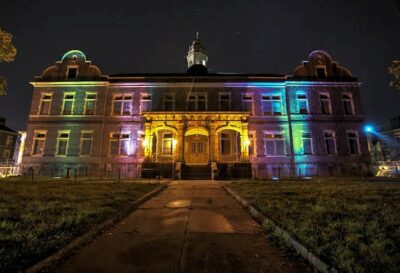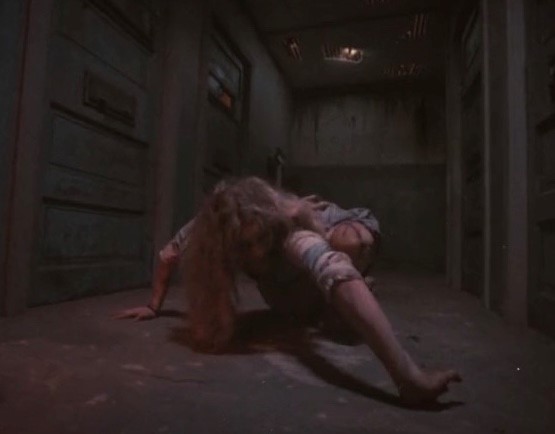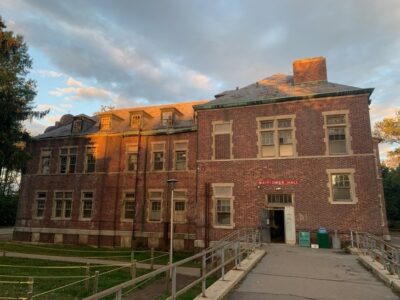Who Should Tell the Story? The Pennhurst Haunted Asylum and the Pennhurst Museum in Public History
07 June 2022 – Diana M. Katovitch

The Pennhurst Haunted Asylum on the Pennhurst property, Spring City, Pennsylvania. Photo credit: Rogues Hollow Productions
The Pennhurst Haunted Asylum and the Pennhurst Museum, operated by Pennhurst LLC in collaboration with the Pennhurst Memorial and Preservation Alliance (PMPA), exist side-by-side on the grounds of the shuttered Pennhurst State School and Hospital in Spring City, Pennsylvania. The sites might seem to have opposite goals: one to frighten and entertain, the other to educate about past wrongs. Over the last decade, however, the haunted attraction and the Pennhurst Museum have become aligned in unexpected ways. New questions are being posed: who should tell the story of Pennhurst, and how should they tell it?
When the Pennhurst State School and Hospital closed in 1987, its buildings and grounds were abandoned. In 2008, a private development group known as Pennhurst LLC purchased the site and planned to use part of it to create the Pennhurst Asylum Haunted House. The clash between preservation and education advocates, on one side, and Pennhurst LLC, on the other, was the original reason for the formation of the PMPA. Despite legal efforts by the PMPA to prevent its opening, the haunted attraction opened in 2010 and began grossing $2 million per year.
The first version of the haunted asylum was as bad as anticipated. A fictional Dr. Chakajian and his minions were shown experimenting on asylum inmates. In a minor nod to the history of Pennhurst, patrons were able to view artifacts retrieved from the property (notably a dentist’s chair and electroshock therapy machine). Yet, historical fact and shock fiction were poorly separated, and visitors were left to wonder which was which.
PMPA members were not the only people to protest the misrepresentation and disrespect of Pennhurst’s history in the haunted attraction. Disability studies historian Sarah Handley-Cousins reflected on the continuing fascination of such sites: “I like a ghost story as much as anyone, but the patients who lived at … Pennhurst weren’t spooky spirits–they were human beings with complex lives.”
In 2017, the ownership of Pennhurst, LLC changed. The new owner and general manager have personal connections to the disability community. Aware of the unintended consequences of a conflated story, they changed features of the attraction and empowered a group of disabled performers with creative control. This new haunted attraction deserves a second look.

Pennhurst Memorial Fellow Autumn Werner, performing her role in the Pennhurst Haunted Asylum attraction. Photo credit: Rogues Hollow Productions
More than half of the performers (called haunters) identify as disabled; a few even have personal histories of institutionalization. This new haunted asylum turns the original plot on its head–the haunters each assume a fictional identity and the inmates conspire to take over the asylum from the professionals. The fictional doctors, nurses, and the visitors become the new inmates. Nathan Stenberg, a doctoral candidate in theatre and performance historiography, board member of PMPA, and a disabled scholar himself, has spent many hours of fieldwork at the Pennhurst site and the asylum attraction. In his words, the asylum attraction “does not simply commodify atrocity, but offers a space where dis/abled people use performance as both self-expression and knowledge-making in a site once designed for their segregation and slow death.” Several of the haunters work giving historical tours of the campus when they are not performing in the attraction.
In addition, the new management now partners with the PMPA to preserve Pennhurst’s past. The Pennhurst Museum was moved from the attraction space into a separate building. In 2020, PMPA established the Pennhurst Memorial Fellowship and several intern positions to continue the historical work on site. Autumn Werner, a psychology major at Westchester University was the first Pennhurst Memorial Fellow; she is a person with a disability and performs in the attraction as a haunter. In a personal email, she explained her involvement this way: “To me, being on the site and performing and building a community as we have has given the disabled population here the power back. We have reclaimed the space and seek to perform, educate, and welcome others into it.”
Werner oversees and organizes the collection of artifacts, often rescuing them from buildings that are collapsing around them. She also staffs overnight paranormal tours of the Mayflower building (which houses the museum), the grounds, and the underground tunnels. She approaches her work with a deep sense of respect and protectiveness of the residents’ stories. “Oftentimes, paranormal investigators may seek to invade sacred spaces, like the Pennhurst cemetery. Our staff will not share the location of the cemetery unless we are certain that the guest has nothing but respect in mind,” Werner wrote. “The (Pennhurst) site itself is a sacred one.”

The Mayflower building is the current site of the growing Pennhurst Museum. Mayflower was once a residential building on the property. Photo credit: Autumn Werner
When they learn about the haunted asylum tour, many people– both disabled and non-disabled–protest that it is disrespectful, especially on the site of a shuttered institution. But the disabled haunters have made a well-reasoned choice to work as performers and tour guides at this former institution. Some people will disagree with their choices. But wholesale condemnation of the attraction may result in refusing to engage with the actual choices and experiences of disabled people. The late disability advocate David Hingsburger said, “We take choice away from people with disabilities all the time…They (disabled people) have a right to the choices that you’ve approved. We don’t want people with disabilities to make choices that run counter to our philosophy….”
One haunter had this to say: “We preserve the property and we’re doing our best to educate people about what happened here… I don’t want them to just walk through here and just think it’s something scary.” Disabled employees of the LLC have given one answer to the complicated question of how best to tell the story of Pennhurst.
The author would like to thank Nathan R. Stenberg for use of information and quotations from his book chapter: “Honoring a House of Horrors: Community, Commemoration, and the Specter of Institutionalization at the Pennhurst Asylum” in Sites of Conscience and the Unfinished Project of Deinstitutionalization: Place, Memory and Social Justice, edited by Linda Steele and Elisabeth Punzi. Vancouver:University of British Columbia Press, forthcoming.
~Diana “Dee” Katovitch is a PMPA advisory board member. She has authored two books on intellectual and developmental disabilities. She is a doctoral candidate at Syracuse University, studying disability in higher education.




According to East Vincent Township’s website, Pennhurst Development LLC is planning to demolish all of Pennhurst’s old buildings and flood the land with parking spaces and Warehouses/Data Centers which means nothing will be left to remember the many individuals who’s lives were spent in agony there.
My name is Leigh Garrison. I am a 44 year old Delaware hospital RN BSN heading back for my masters. I was watching Portals to Hell with Jack Osborne and Katrina, It taught me soooo much! I am from Delaware, with Phili just an hour and half away. I want to go, learn, and even move into psychology. I want to help others with disabilities continue to improve. Thank you for this article. I will continue to study. Thank you. Leigh Garrison
Oh I so hope not demolished. It needs to be left for people to continence to learn the unjustified of the disabalbled population. Amen! And I rarely go to church…… but Amen! Continue scaring, teaching, educating. Scaringets people there, must generate money,and encourages conversations of disabled, how to treat diisabed,and treat everyone with great love and respect. If people kids, have a great scare, laugh, have fun,they will want to talk about what it was like to live there. Educate themselves. Grat idea! Thanks to all who go and do!
They appear to be taking ticket orders for this fall season, but the potential for demolition is on the table. In fact, it doesn’t appear that other options are at this time.
I hope not to demolish this history of what has happened to those people at the time with disabilities. We need to know the history keep those buildings up for those who had to experience life and for the spirits that are there. Also if you have the museum and bringing money in then it just don’t make sense why to stop having tours and helping our disabled people to teach and continue to learn for everyone!!!!
Would you turn Buchenwald or Auschwitz into a for profit “fun house” or give Halloween Haunt events? This is the most vile, disrespectful and degenerate thing I have ever heard of! This is not the way to shed light on the misery and abuse of very vulnerable and defenseless people who suffered at the hands of the state!
Lisa either didn’t bother to read the article so she could ride in on her high horse, or conveniently ignored the David Hingsburger quote right in the article:
“We take choice away from people with disabilities all the time…They (disabled people) have a right to the choices that *you’ve* approved. We don’t want people with disabilities to make choices that run counter to *our* philosophy….”
So once again, an able-bodied know-it-all has decided to condemn the work disabled folx are doing because it doesn’t fit in with *their* ableist notions of how Pennhurst should be “correctly” honored and remembered. Tell us Lisa, are you ACTUALLY a member of the disabled community? And if you are, why is it so hard to accept that other disabled folx will have differing views and opinions? You try to compare it to concentration camps of N*zi Germany, while again, conveniently forgetting that many of those sites – including Auschwitz, are already operating as tourist hotspots where thousands of people from all over the world visit on a daily basis! They’re not “haunt attractions” but they still rely on tourist money to keep those historical sites up and running. Does that not get your dander up as being “inhumane”, “disrespectful” yadda yadda yadda because they are essentially profiting off real human atrocities? And if you want to try to argue that these historical sites serve as “teachable moments” for self-proclaimed History Buffs… the Pennhurst Haunt is doing the same thing by the insistence of the disabled scareactors that work there as haunt employees and members of their historical preservation society.
So again, what exactly is the difference between what Pennhurst is doing and what Auschwitz does besides the fact that *you* personally agree with one and not the other because you believe one is “respectful” while the other isn’t? (All while casually being ableist by taking away the autonomy of disabled folx to make their own decisions because you don’t like that they don’t agree with you.)